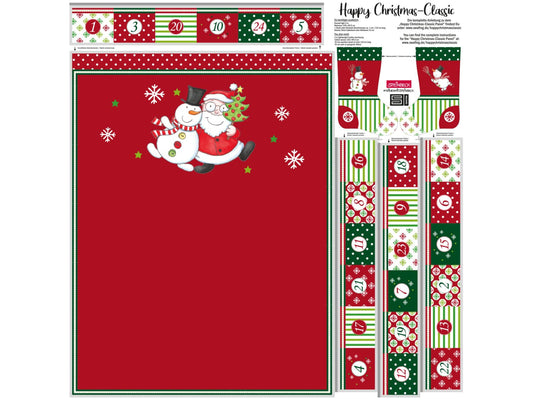-
Canvas fabric PANEL - DIY Bag Thorsten Berger - Boo Hoo
Regular price €11,90 EURRegular price -
Canvas Fabric PANEL - DIY Bag Thorsten Berger - Walking Zombies Crossing
Regular price €11,90 EURRegular price -
Canvas fabric PANEL - DIY Bag Thorsten Berger - Good Girl, Bad Girl
Regular price €11,90 EURRegular price -
Canvas fabric - PANEL Elements by Cherry Picking - ocher
Regular price €12,90 EURRegular price€16,90 EURSale price €12,90 EURSale -
Canvas fabric - PANEL Elements by Cherry Picking - blue
Regular price €12,90 EURRegular price€16,90 EURSale price €12,90 EURSale -
Canvas fabric - PANEL Advent calendar Happy Christmas Classic, red
Regular price €19,50 EURRegular price€24,90 EURSale price €19,50 EURSale -
Canvas Fabric - Pillow Party DIY Panel - Hope
Regular price €16,50 EURRegular price -
Canvas Fabric - Pillow Party DIY Panel - Celebration
Regular price €16,50 EURRegular price -
Canvas Fabric - Pillow Party DIY Panel - Berries
Regular price €16,50 EURRegular price -
Milan velvet - mustard
Regular price €7,45 EURRegular priceUnit price €14,90/m -
Milan Velvet - red
Regular price €7,45 EURRegular priceUnit price €14,90/m -
Milan velvet - old pink
Regular price €7,45 EURRegular priceUnit price €14,90/m -
Milan velvet - mauve
Regular price €7,45 EURRegular priceUnit price €14,90/m -
Milan upholstery velvet - smoke blue
Regular price €7,45 EURRegular priceUnit price €14,90/m -
Milan velvet - marine
Regular price €7,45 EURRegular priceUnit price €14,90/m -
Milan velvet - mud
Regular price €7,45 EURRegular priceUnit price €14,90/m
Collection: Canvas
Stoffwissen - Canvas
How is canvas fabric made and what properties does it have?
Canvas fabric was originally sailcloth. Canvas, duck or canvas fabric is a textile that is woven from robust yarn in a dense, stable, strong and stiff manner, which is why it is often used outdoors. It used to be made from pure hemp and linen, but today cotton is mainly used for canvas fabrics.
As described above, canvas is made from natural fibers such as hemp and linen, but there are also increasingly mixed fabrics with polyester and other chemical fibers. This textile is a woven fabric that is produced in various weaves. The classic plain weave used is muslin (where the warp threads are woven over and under the weft threads), Panama and half-Panama weaves, and ripstop weaving techniques. Canvas is available in various yarn thicknesses. Canvas is generally used when it weighs 237g/m² or more. If the fabric is lighter, it is referred to as balloon, aircraft or nettle fabric.
Canvas has many great properties that make this textile a valued material. It is a rather coarse product, but is very stable, robust and stiff. It is particularly popular in the outdoor sector due to its wind-repellent, sun-repellent, opaque and tear-resistant properties. Despite its high density, the natural fibers mean that it is a breathable material, which is considered to be flame-retardant due to its design. It absorbs color well, which is why it is available in many color variations. Despite its stability and robustness, it is comparatively light.
For which sewing projects are canvas fabrics particularly suitable?
Canvas by the meter is a popular and versatile material that is characterized above all by its resistance and durability. Accordingly, there are many great uses for canvas by the meter, both indoors and outdoors. Canvas is often used for example for:
- accessories
- editions
- Relation
- espadrilles
- cases
- curtains
- wallet
- hammocks
- covers
- hat
- Pants
- canvas
- Lay
- jackets
- Coat
- pad
- travel bags
- Backpack
- beanbag
- sneakers
- duffel bag
- awnings
- bags
- Set the table
- Tent
Canvas fabrics are particularly popular as trendy bag fabrics for, for example, wonderful DIY summer beach bags and furnishings in country house style!
Sewing tips and care instructions for canvas fabric
What needs to be considered when cutting and sewing canvas by the meter?
With canvas, as with most other fabrics, you have to pay attention not only to the pattern but also to the grain so that the elasticity is appropriate across the width. When applying the cut pieces, a thimble helps to ensure that the pins are firmly secured in the solid material. Canvas is a rather dense and thick material, which is why you need sharp scissors or a sharp rotary cutter to make your work easier.
Because of its good grip, canvas is also great for beginners. Even if it is multi-layered, canvas fabric can usually be processed well with a standard household sewing machine. It is best to use strong sewing thread and a 90 - 100 denim needle for sewing. As far as the sewing machine feet are concerned, a denim foot or a quilting foot make sewing even easier, as the material is less likely to shift. The upper thread tension may need to be loosened so that there are no visible loops from the lower thread. With such a strong material, you should also sew slowly and carefully.
For furniture or bulky, awkward decorative items, it is recommended to simply glue or staple canvas to make the work easier.
How do you care for canvas fabric?
Canvas is generally a very easy-care material, but should be cleaned carefully. The coated versions in particular are resistant to splashes and dirt. For covers, bags and shoes made of untreated canvas, however, a standard dirt eraser can be used first to remove stains. Alternatively, soap and a sponge may be sufficient. This is the easiest way to clean bulky canvas-covered projects such as furniture.
For washing in the washing machine, a washing temperature of 30°C is recommended in order to preserve the material and color quality as best as possible. Strong spinning should be avoided in order to protect the weave structure. Delicate wash programs and the use of mild detergent are generally suitable for this. Bleach should be avoided, as otherwise the colors can fade too quickly.
The dryer should also be avoided, as canvas has a very high cotton content. Canvas fabric dries best when left to air dry. An absorbent mat may need to be used, depending on how wet the fabric comes out of the machine. Canvas can be ironed on a low to medium heat after drying. Steam should be avoided.















